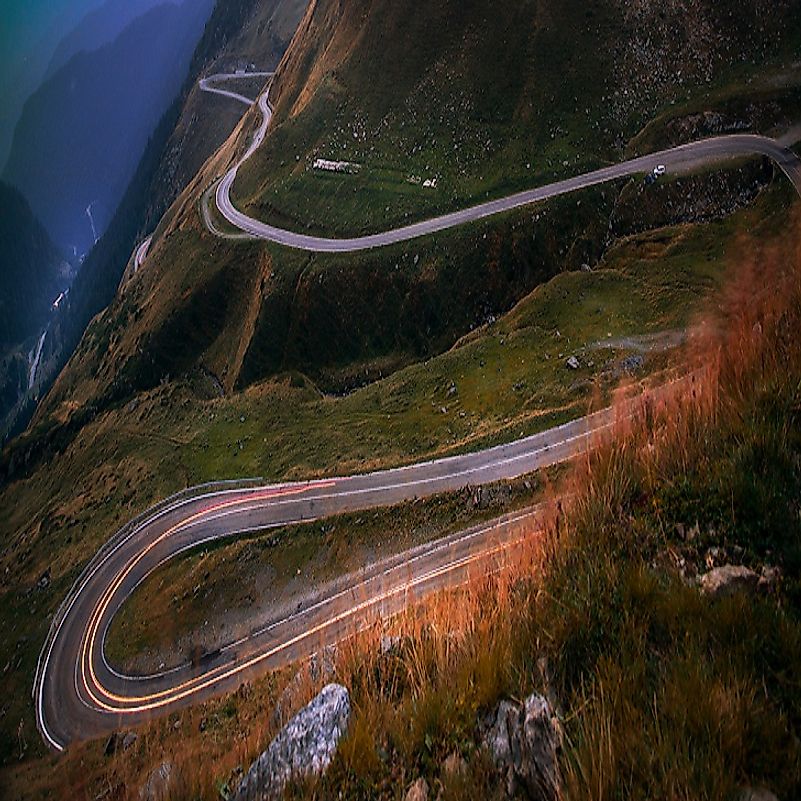Transfagarasan, Romania - Unique Places Around the World

5. Description
The Transfăgărașan is a national highway connecting the Romanian regions of Wallachia and Transylvania. The route runs through Romania’s southern Carpathian mountain range, specifically across the Făgăraș Mountains. The road is about 94 miles (151 kilometers) in length, with the large cities of Pitești, Wallachia and Arpașu de Jos, Transylvania lying at opposing ends of the route. The northern part of the road runs through a nature reservation and passes a glacier lake, as well as one of Romania’s largest waterfalls. Due to the heavy snowfall that is common there, the road is closed from June 30th to November 1st. Though a rather remote location, the mountainous and serpentine route is a popular tourist destination for Romanians and foreigners alike, especially after its appearance in 2009 on BBC Television’s Top Gear.
4. Tourism
The scenic mountain highway is nicknamed the "Road Through the Clouds". Visitors come to see the Goat’s Waterfall (Cascada Capra), the largest waterfall in Romania at a length of 223 feet (68 meters), and the impressive Vidraru Dam. The Poienari Fortress, with its 1,480 steps, offers a stunning view of the surrounding forests and mountains as well. Built in 1453, the fortress's ruins can be traced back to legends of the infamous Vlad the Impaler. During the months in which the road is closed, cable cars transport visitors across the snowy mountains to Balea Lake. The paved roads across the Transfăgărașan make it more accessible than Romania’s other famous mountain highway, the Transalpina.
3. Uniqueness
The road was constructed between 1970 and 1974, initiated upon the request of Communist dictator Nicolae Ceausescu. It was officially inaugurated on September 20th, 1974. 6,520 tons of dynamite were used to build a path through the Carpathian mountain rock. Two official monuments can be found on the road, which commemorate the military men, many of which lost their lives, who built the Transfăgărașan. The former villa of Ceausescu, a residence of the aforementioned dictator, still stands along the way, and tourists can reserve a room inside. Some say the highway was constructed for strategic military reasons after the Soviet invasion of Czechoslovakia in 1968, while others simply refer to it as Ceausescu's Folly, an icon of waste and unnecessary pomposity.
2. Habitat
Due to the cold climate at the higher altitudes along the highway, the animals and plant life which live there are those accustomed to snow throughout the year, such as foxes and bears. The nature reservation which the highway passes through, named the Golul Alpin, has goats, deer, wolves, and lynxes, among other animals, as well as such plant life as the beloved floarea de colt, or Edelweiß, which are protected by the International Union for Conservation of Nature. The road is also used by farmers to transport their sheep by foot to grazing lands, a practice resulting in occasional road blocks.
1. Threats
The Transfăgărașan is a dangerous, yet beautiful, place to travel, especially if visitors are reckless or unprepared. Tourists are warned beforehand of the possibility of rockslides and snow avalanches. The speed limit is 40 kilometers an hour much of the way, due to the numerous sharp curves and the unexpected animals that may jump in front of vehicles. Steep drops of 1,000 feet alongnon-barriered roads have led to the death of some visitors, particularly in instances of vehicular brake failures. Humans, however, also pose a danger to the area themselves. A number of species are listed as threatened live along the highway, especially certain native wildflowers. Commercial activities and illegal tourism are listed as some of the most significant dangers to the area's natural habitat. Non-Governmental Organizations and universities from Romania and Hungary alike are currently working together to implement conservation plans on and around the Transfăgărașan.







